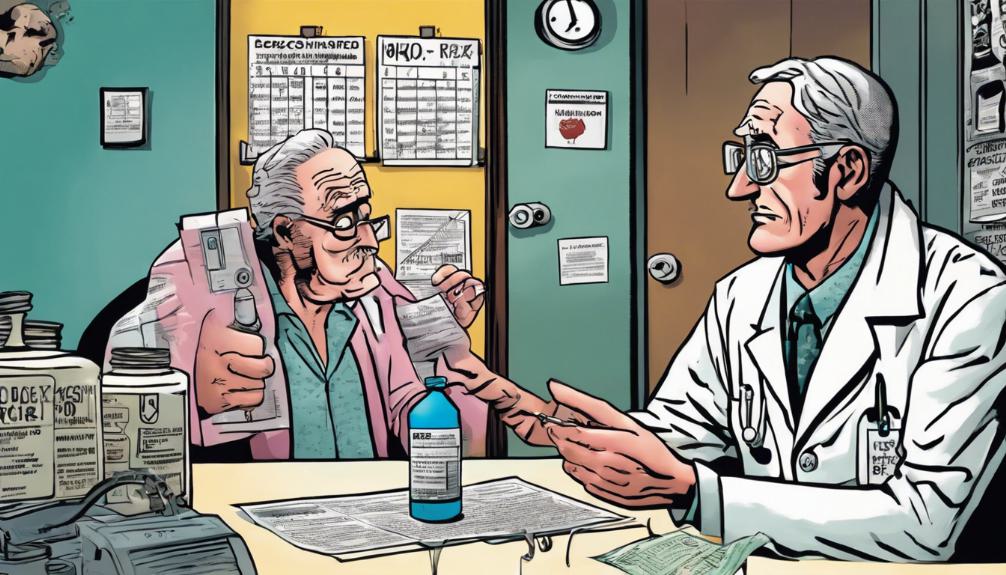More Evidence Linking Common Bladder Medication to a Vision-threatening Eye Condition
The recent compilation of studies highlighting a link between Elmiron, a widely used medication for interstitial cystitis, and severe retinal damage, presents a compelling case for reevaluation of its safety profile. As the sole FDA-approved drug for a condition that affects a significant number of Americans, the implications of these findings are profound. The research, spearheaded by specialists at Kaiser Permanente, reveals that prolonged exposure to Elmiron may lead to a form of retinal toxicity that mirrors symptoms of other devastating eye diseases. This revelation prompts a critical discussion on the necessity of regular retinal examinations for patients on Elmiron and the exploration of alternative treatments to prevent irreversible vision loss. The urgency of addressing this issue cannot be overstated, inviting a closer examination of the balance between treatment benefits and potential risks.

Elmiron Overview
Elmiron, scientifically known as pentosan polysulfate sodium, is the only FDA-approved oral medication specifically prescribed for the treatment of interstitial cystitis, a chronic condition characterized by bladder and pelvic pain. This condition, primarily affecting over a million Americans, most of whom are women, poses significant challenges in daily life due to its discomfort and pain. Elmiron's mechanism of action is not fully understood, but it is believed to provide a protective coating to the bladder lining, potentially shielding it from irritating substances in the urine that may exacerbate symptoms of interstitial cystitis. Despite its unique therapeutic role, patients are advised to discuss long-term use and possible side effects with their healthcare providers, ensuring a balanced approach to managing this debilitating condition.
Retinal Damage Risks

A significant body of research has established a concerning link between prolonged use of bladder medication and the risk of developing vision-threatening retinal damage. Specifically, Elmiron, the only FDA-approved medication for interstitial cystitis, has been observed to cause retinal damage in patients with long-term exposure. A study conducted by Kaiser Permanente found that 25% of patients with significant Elmiron exposure exhibited signs of retinal damage. This condition can mimic other retinal diseases, such as macular degeneration, complicating diagnosis and treatment. The risk of irreversible vision loss underscores the importance of early detection. Therefore, regular retinal screenings are recommended for patients taking Elmiron, even in the absence of symptoms, to prevent permanent damage. Those exhibiting signs of retinal toxicity should consult their healthcare providers promptly.
Interstitial Cystitis Explained

Understanding interstitial cystitis, a chronic condition characterized by bladder and pelvic pain, is crucial for patients and healthcare providers alike. This complex condition affects over 1 million Americans, predominantly women, and presents a significant challenge due to its elusive etiology and variable symptomatology. It manifests as a spectrum of symptoms including urgency, frequency, and pain in the bladder and pelvic region, severely impacting the quality of life of those affected. The diagnosis is primarily clinical, relying on the exclusion of other similar conditions, making it a diagnosis of exclusion. Treatment focuses on symptom management, employing a multidisciplinary approach that can include lifestyle modifications, physical therapy, and medication. Elmiron, the only FDA-approved medication specifically for interstitial cystitis, plays a vital role in management strategies, highlighting the necessity of understanding this condition for effective patient care.
Elmiron's Unique Position

Occupying an exclusive niche, Elmiron is the only medication approved by the FDA for the treatment of interstitial cystitis, positioning it as a cornerstone in managing this challenging condition. This unique status underscores the critical role Elmiron plays in the therapeutic landscape for over a million Americans, predominantly women, grappling with the debilitating symptoms of interstitial cystitis. The absence of alternative FDA-approved medications elevates Elmiron's significance, making it a primary option for patients seeking relief from chronic bladder and pelvic pain. Consequently, the revelation of its potential link to retinal damage presents a complex dilemma for both patients and healthcare providers. It necessitates a careful balance between managing interstitial cystitis symptoms and mitigating the risk of vision-threatening side effects, highlighting the importance of ongoing research and patient monitoring.
Study Insights

Building on the foundational knowledge of Elmiron's crucial role in treating interstitial cystitis, recent studies offer deeper insights into its associated risks, particularly concerning retinal toxicity. Research conducted by ophthalmologists at Kaiser Permanente quantitatively assessed the prevalence of retinal damage in patients with significant exposure to Elmiron. Their findings startlingly revealed that 25% of these patients exhibited signs of retinal toxicity, a condition which can lead to irreversible vision loss if not promptly identified and managed. This study underscores the importance of regular, comprehensive eye exams for individuals undergoing Elmiron treatment, to ensure early detection of any adverse effects on the retina. It also highlights the necessity for healthcare providers to be vigilant in monitoring patients on long-term Elmiron therapy, to mitigate potential vision-threatening complications.
Misdiagnosis Concerns

The potential for misdiagnosis of retinal damage linked to Elmiron poses significant challenges for healthcare providers and patients alike. Given that the symptoms of Elmiron-induced retinal toxicity closely resemble those of other retinal conditions, such as macular degeneration, distinguishing between these can be complex. This complexity is compounded by the fact that Elmiron is the only FDA-approved treatment for interstitial cystitis, leading to its widespread use among patients suffering from this chronic condition. Consequently, healthcare professionals must be vigilant in considering Elmiron toxicity as a differential diagnosis for patients presenting with retinal abnormalities. Failure to do so not only risks incorrect treatment but also the possibility of irreversible vision loss due to continued exposure to the drug.
Increased Toxicity Rates

Recent studies have demonstrated a concerning correlation between prolonged Elmiron usage and elevated rates of retinal toxicity. This connection is significant, given the widespread prescription of Elmiron to treat interstitial cystitis, a chronic condition affecting over a million Americans. Research, particularly a study by Kaiser Permanente, has shown that 25% of patients with significant exposure to Elmiron display signs of retinal damage. This damage often mimics other conditions like macular degeneration, complicating diagnosis and treatment. The risk of toxicity increases with the duration and amount of Elmiron consumption, highlighting a troubling trend for long-term users. Such findings underscore the urgent need for heightened awareness and consideration of potential risks associated with Elmiron, especially for those on prolonged treatment regimes.
Monitoring Recommendations

Given the significant risk of retinal toxicity associated with Elmiron, regular and comprehensive eye examinations are strongly recommended for patients undergoing treatment. The linkage between long-term Elmiron use and retinal damage necessitates vigilant monitoring to catch early signs of toxicity. According to the findings from Kaiser Permanente, a staggering 25% of patients with substantial exposure to Elmiron exhibited signs of retinal damage, underscoring the importance of early detection. Patients without symptoms should undergo annual screenings, whereas those displaying potential signs of retinal damage must consult their healthcare provider promptly for a more thorough evaluation. Implementing such proactive monitoring strategies is critical in mitigating the risk of irreversible vision loss, thereby ensuring patient safety and health outcomes are optimized.
Preventing Vision Loss

To mitigate the risk of irreversible vision loss associated with Elmiron use, patients are advised to undergo regular, comprehensive eye examinations. These screenings are crucial for early detection of retinal damage, which may not present immediate symptoms but can lead to significant visual impairment over time. Healthcare professionals recommend that even patients without visible signs of retinal toxicity should have their eyes examined annually. For those with detected abnormalities or who have had prolonged exposure to Elmiron, more frequent monitoring may be necessary. It's imperative that these evaluations include detailed imaging of the retina to identify any changes that could indicate the onset of Elmiron-induced damage. Early diagnosis plays a pivotal role in preventing the progression of retinal toxicity and safeguarding patients' vision.
Exploring Treatment Alternatives

As Elmiron's potential for causing significant retinal damage becomes more evident, exploring alternative treatments for interstitial cystitis is crucial for patient safety and health. Given the growing body of evidence linking long-term Elmiron use to vision-threatening conditions, the medical community is urged to consider and research safer therapeutic options. These alternatives may include dietary modifications, physical therapy, stress management techniques, and other medications that have not been associated with severe side effects. Pain management strategies, such as the use of non-steroidal anti-inflammatory drugs (NSAIDs), may also offer relief without the risk of retinal damage. Additionally, bladder instillations containing compounds that protect the bladder wall can be an effective treatment. The exploration of these alternatives is vital to ensure the well-being of patients suffering from interstitial cystitis.
Patient Consultation Advice

Healthcare professionals should initiate discussions with patients currently taking Elmiron about the medication's potential risks and explore alternative treatments for interstitial cystitis. Given the study findings at Kaiser Permanente, which revealed a significant 25% of patients with considerable Elmiron exposure exhibited retinal damage, a proactive approach in patient counseling is crucial. It is imperative that healthcare providers inform patients about the possibility of irreversible vision loss associated with long-term Elmiron use. Moreover, they should advise patients, even those without signs of toxicity, on the importance of annual retina screenings to detect any early signs of retinal damage. This practice not only aids in early detection but also facilitates timely intervention, potentially preventing permanent vision loss.
Awareness and Prevention

Building on the importance of patient consultation, raising awareness and implementing preventive measures are critical steps in addressing Elmiron-related retinal toxicity. As the link between Elmiron and potential vision-threatening conditions becomes more evident, healthcare providers and patients alike must be vigilant. Informing patients about the risks associated with long-term Elmiron use, emphasizing the significance of regular retinal screenings, and exploring alternative treatments for interstitial cystitis are paramount. By fostering an environment of open communication, healthcare professionals can ensure that patients are making informed decisions regarding their treatment options. Additionally, the development of guidelines for monitoring and managing Elmiron-induced retinal changes is essential. Early detection is key in preventing irreversible damage, underscoring the necessity for annual eye examinations for those on Elmiron therapy.
Frequently Asked Questions
How Does Elmiron Specifically Interact With the Retina to Cause Damage?**
Elmiron, a medication prescribed for interstitial cystitis, has been associated with retinal damage through studies, including those conducted by Kaiser Permanente. The exact mechanism by which Elmiron interacts with the retina is not fully understood, but evidence suggests that prolonged exposure to the drug may lead to pigmentary maculopathy, a condition that mimics other retinal disorders like macular degeneration. This retinal damage is characterized by changes in the macula, potentially resulting in irreversible vision loss.
This Question Seeks a Detailed Explanation of the Biochemical or Physiological Mechanisms by Which Elmiron Affects Retinal Cells, Potentially Leading to Damage.
The inquiry pertains to elucidating the biochemical or physiological processes through which Elmiron exerts negative effects on retinal cells, potentially culminating in damage. Understanding these mechanisms is crucial for comprehensively grasping the adverse impacts Elmiron may have on visual health. It involves exploring how Elmiron's interaction with retinal tissue might disrupt cellular functions or structures, leading to the observed outcomes of toxicity and, consequently, vision impairment or loss in patients.
Are There Any Known Genetic Predispositions That Could Make Certain Individuals More Susceptible to Elmiron-Induced Retinal Damage?**
The inquiry pertains to whether specific genetic predispositions might increase an individual's susceptibility to retinal damage induced by Elmiron, a medication prescribed for bladder conditions. Although extensive research has documented Elmiron's link to retinal toxicity, further investigation is required to ascertain the role of genetic factors in this adverse effect. Understanding genetic vulnerabilities could enhance patient screening and prevent vision loss by facilitating personalized treatment approaches for those at heightened risk.
This Question Inquires Whether Genetic Factors Could Influence the Likelihood of Experiencing Retinal Toxicity From Elmiron, Making Some Patients More at Risk Than Others.
The inquiry pertains to whether genetic predispositions may heighten the risk of retinal toxicity in patients using Elmiron, a treatment for interstitial cystitis. Research indicates that Elmiron can cause retinal damage, particularly with long-term use. Understanding if specific genetic factors contribute to increased susceptibility could enhance patient care by allowing for personalized treatment plans and monitoring strategies, thereby mitigating potential vision loss associated with Elmiron-induced retinal damage.
What Are the Financial Implications for Patients Needing Treatment for Elmiron-Related Eye Conditions?**
The financial implications for patients requiring treatment for Elmiron-related eye conditions can be significant. Costs may include diagnostic imaging, ongoing ophthalmologic evaluations, and potential interventions to manage or mitigate vision loss. Given that Elmiron is the only FDA-approved medication for interstitial cystitis, patients facing retinal damage also confront the challenge of finding alternative treatments for their bladder condition, which may incur additional expenses. Early detection through regular screenings is crucial to prevent irreversible damage and associated costs.

This post has been generated by AI and was not reviewed by editors. This is Not legal advice. Please consult with an attorney.




